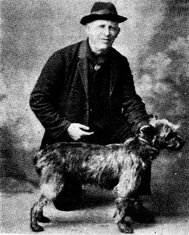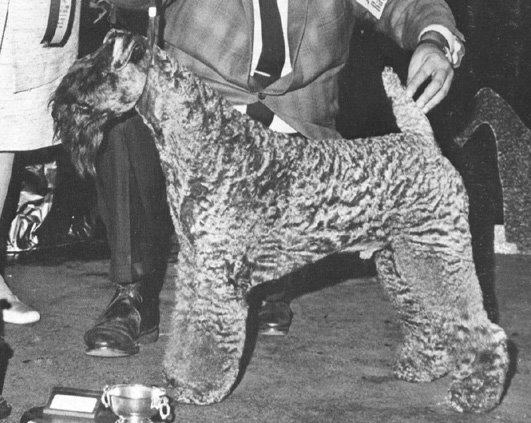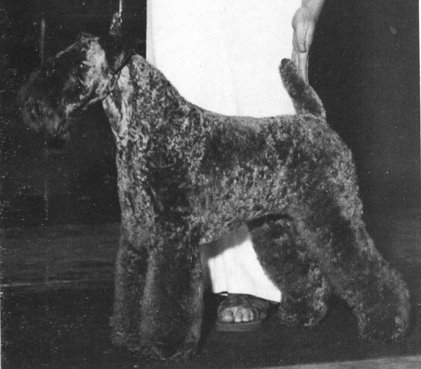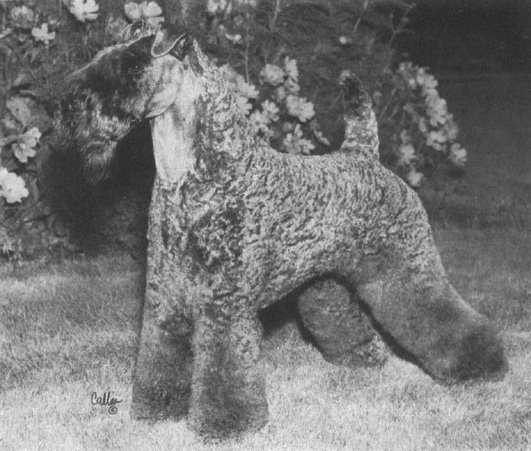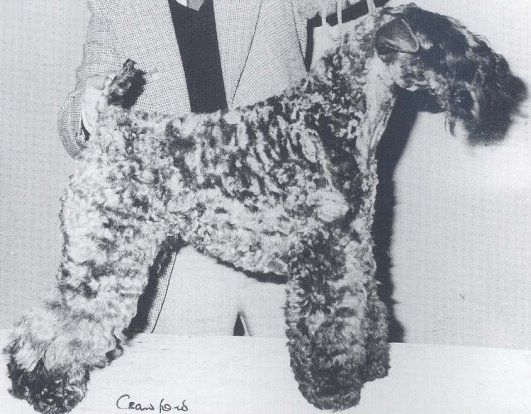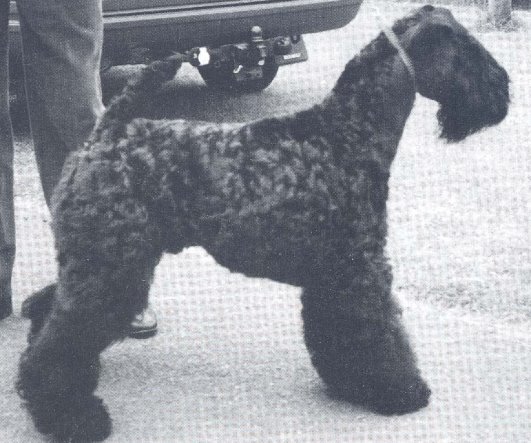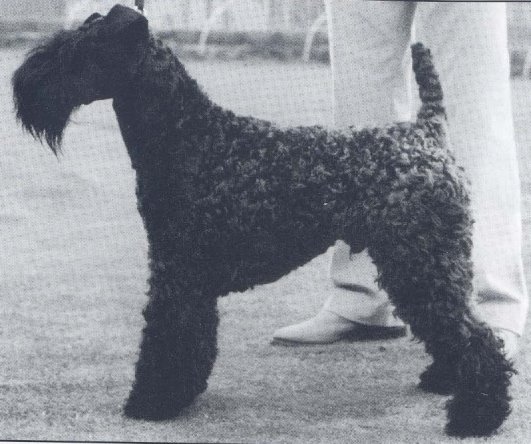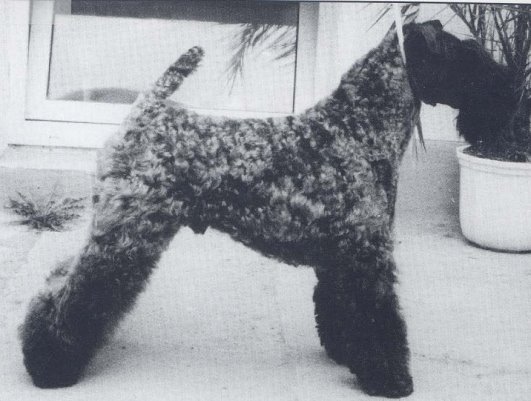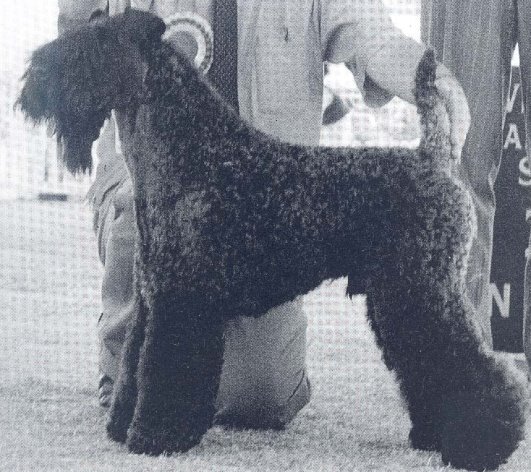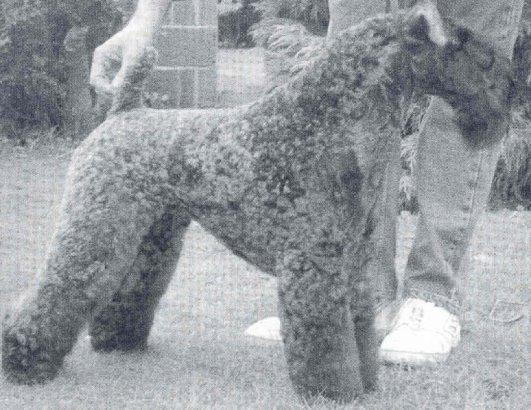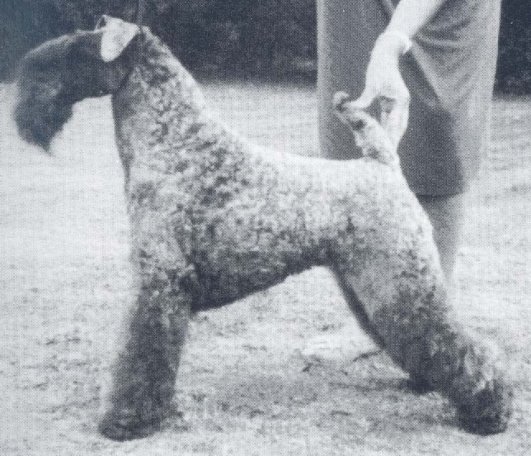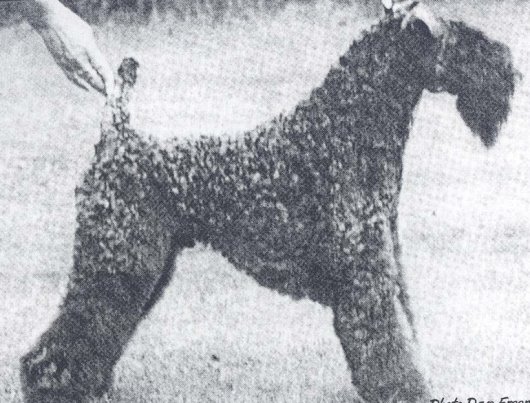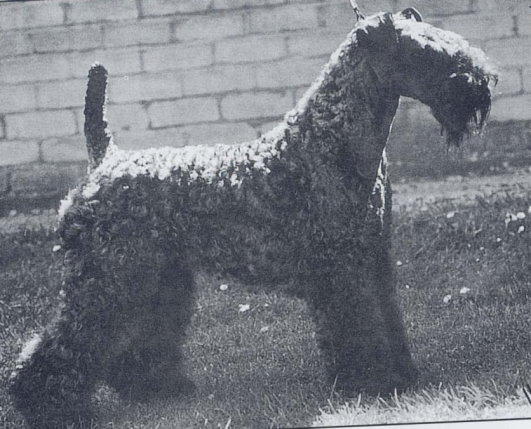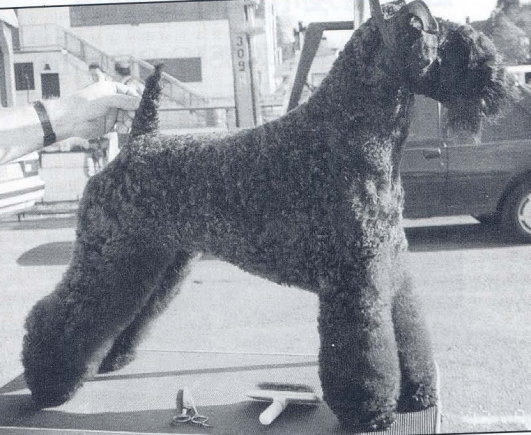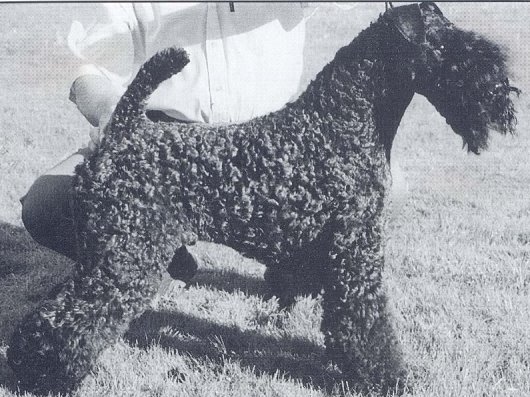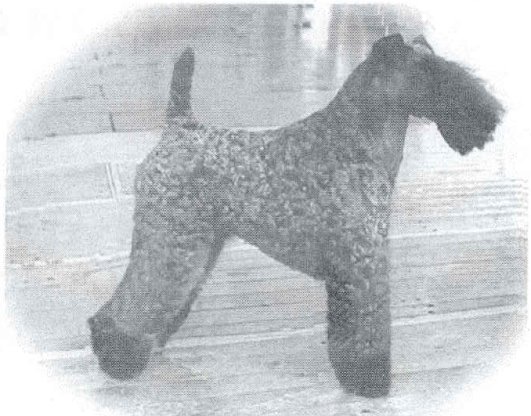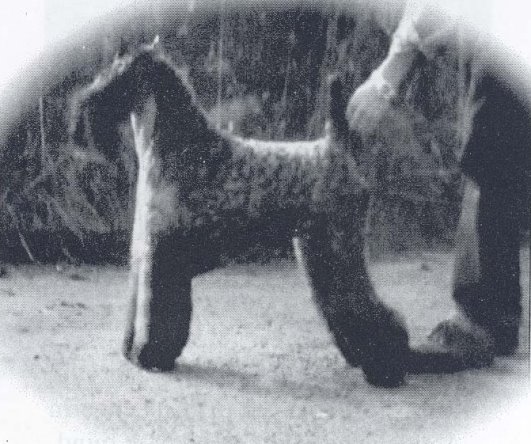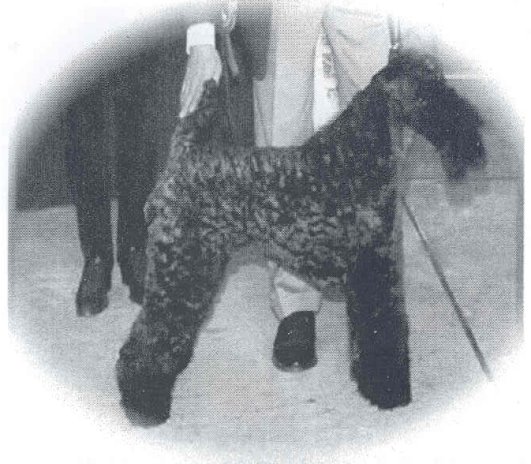|
THE MYSTERY OF THE IRISHBLUE
There‘s a lovely tale as to the origin of the Irish Blue Terrier, or the breed known outside its native land as the Kerry Blue Terrier. It seems one day in the distant past, as the story goes, a ship was wrecked in Tralee Bay. A beautiful blue dog swam ashore and was found to be such a game terrier that all the wheaten terriers in County Kerry (or the whole of Ireland, if you care to believe it) were bred to him. And thus the beautiful Irish Blue Terrier evolved. You‘ll have to agree it does have the flavour of Irish folklore about it. The usual arguments over a breed‘s dubious origins, which exist even within a small island area, are heard to this day in vociferous Celtic debates between terrier breeders of the Irish (or Kerry) Blue, the red Irish Terrier, the Soft Coated Wheaten and the Glen of Imaal. There are almost as many claims regarding what went into the breed as there are breeders and writers on the subject. It would seem each stands by one or another version of the Kerry‘s history and, since no concrete proof is available to substantiate any one view as absolutely right or wrong, the guessing game continues. In Baerla, the earliest of the Brehon Code, dating from the first century, rules were laid down as to the breeding, ownership and care of dogs in Ireland. Only the Irish nobility was allowed to breed and hunt with Irish Wolfhounds, for example. It was not unusual for noblemen to claim as their own all dogs used for hunting and guarding. Similar written laws were in effect in Wales. The terriers were the designated dogs of the peasantry and as such became good vermin hunters to have around the farms. Their speed in bringing down rabbit made them well suited for poaching on the land of the gentry. � One theory would have the Kerry Blue as the progenitor of all other Irish terrier breeds. Another is that the Soft Coated Wheaten was the taproot, combined with that infamous blue or black dog that swam ashore. Or, perhaps it was the Irish Terrier, which is now only red, hut according to Rawdon Lee, writing in 1894, was accepted also in black, brindle or blue. It was said by some that was the Irish Terrier crossed with the Bedlington Terrier (or even Bedlington crossed with the Irish which produced the Irish Blue. Or was it the Wheaten crossed with the Irish Wolfhound, keeping in mind the Wolffhound of yesteryear was a smaller dog than the giants we know today? Still others would have the Wheaten crossed with the Bull Terrier or the now-extinct Old English Terrier. Well, you begin to see where all this leaves us: With a completely unsolvable mystery. Guesses, theories and leprechaun like legends abound, but the facts are few and far between. This island nation‘s ancient history of sea trade with most of the known world as well as the British Isles undoubtedly included the occasional exchange of a pup or two, lending credence to the ‘blue dog that swam ashore.‘ However, clan warfare, famines and mass migrations from Ireland must also have had an impact on the native breeds of dog. When any nation suffers from man-made or natural disasters, the continuance of purebred dogs is inevitably left to a few dedicated and more fortunate individuals. During a famine, with little food for the family, there would not be much left to feed dogs, which in better times would have been well cared for and bred to further their working ability. And ‘working ability‘ is the key. Prior to the competitive dog show, the value of any dog was based solely on its performance, which in the case of the Kerry Blue was to control vermin, herd livestock, retrieve fowl from land or lake, dispatch he odd river otter and protect the owner‘s home as an alert watchdog. The deciding factor in mating with a neighbour‘s dog would have been its skill in any of these essential areas. Extremely few breeds, as we know them today, were truly pure-bred from the start. Breeds have always been crossed in order to produce a dog better able to do the work required of it. There is little doubt that matings— especially those done during the bleak periods in Irish history— involved a mixture of breeds. In 1886, Stonehenge (one of 1w best known early writers on dogs) judged a coursing terrier match and commented on the gameness of a blue Irish terrier. In 1892 there was also a reference to the ‘gamest and truest breed of terriers—the blue devils.‘ However, this latter is likely a reference to those dogs in the Dublin area that were in fact Bedlingtons, not Kerries, This led Edward C Ashe to surmise that the true makeup of the Kerry Blue was the Bedlington crossed with the red Irish Terrier and, he added, ‘perhaps the Dandie Dinmont.‘ Old writings on the terriers in Ireland refer to them in every possible colour: red, wheaten, blue-grey, black and tan, grizzle and brindle. Several writers go so far as to mention the Glen of Imaal as mostly blue and tan or blue-brindle as well as wheaten and thus put forth their claim to the Irish Blue. lt is equally possible that the real truth lies in the simplest, or most obvious, format. A black, or even a black and tan, terrier, long an Irish resident, was purposely crossed with the wheaten coloured farm terrier. Of the resulting pups, only the blue mutations were kept for further breeding (whether more for their skills or their unusual colour, we may never know). Some of the physical similarities of the Blue and the Soft Coated Wheaten would certainly favour such a combination. But then there is that nagging suspicion that early in the last century a Portuguese Water Dog or two may have been taken in trade for sheep, to add ‘water retriever‘ to the native terrier‘s list of accomplishments. We do know that the breed, as we see it today, is not exceptionally old. Despite an occasional reference to a breed of this general type having been seen in and around County Kerry ‘for some time,‘ there is nothing to substantiate these vague claims, The first reference made to classes for ‘silver-haired Irish terriers‘ was a show at Limerick in 1887, of which five were said to be a lovely slate-blue. In 1892 a show near Killarney held a class for Irish Terriers (Blue). However, in 1900 at a Dublin show, the renowned terrier judge from America, Charles G Hopton, dismissed dogs exhibited in this Irish Terrier class as ‘half-bred Bedlingtons.‘ Two years later, that same show offered a class for Blue Terriers (Working) and 14 blue-grizzle dogs were entered. (lt should be noted here that Hopton apparently changed his low opinion of this new breed and himself imported a slate-grey Kerry Blue to America in 1921.) IRISH RHAPSODY IN BLUB: THE KERRY COMES OF AGE The breed called the Irish BIue Terrier was benched for the first time in 1913 at a dog show in Cork judged by the all-breed judge, Frank Butler, who found the dogs to be quite small and still blue-grizzle. Then, in September 1916, he judged a show in Killarney where the breed was first called the Kerry Blue Terrier, and he was more definitive, but no more impressed. There were 20 Blues entered and despite the cheering from spectators and exhibitors alike, Mr Butler wrote, ‘The exhibits were all sizes, from a small Fox Terrier to an Old English Sheepdog and certainly resembled the latter breed very much, most of them being blue in colour.‘ His Best of Breed was a bitch, Blue Belle, owned by Miss Casey, who later became Mrs Casey Hewitt of the famous Munster kennels. The determination of Miss Casey and the quality of that bitch marked the beginning of uniformity in the Kerry breed. The Dublin Irish Blue Terrier Club (DIBTC) was organised in 1920 and managed to bring together leaders from both sides of the political aisle (pro and con Irish national independence). It is amazing to ponder that these hot politicians could join hands over a dog! Due to the tolerance invoked by :he DIBTC, Dan Nolan, despite being wanted by British authorities for his Republican Army activities, was asked to judge the first show held by the club at Longrishe Place, Dublin on 16 October 1920. The show was held after Curfew, which was law at that time and thus all participants were at a great risk. Michael Collins, Ireland‘s renowned patriot, whose Irish Blue Terrier, Convict 24, was almost as famous as his politician-owner in the 1920s, tried to have the breed accepted as the National Dog of Ireland. He did not succeed in that venture, but remained an avid promoter of the breed. In 1922 members of the DJBTC organised a meeting to form the Irish Kennel Club (IKC) in opposition to the Kennel Club of England. The supporters of the breed were a dnterminecl lot! The first dog with tlie IKC was a Kerry fl 1 ne Terrier narned Fuamnach, owned by Harry B Fottrell. In 1922 The Kennel Club in London officially recognised the breed as the Kerry Blue Terrier, named for the area felt to be most closely associated with its origin. Other breeders in southern Ireland were a bit put out by the Kerry appellation, basing their displeasure on the grounds that the breed did not originate solely in County Kerry. Eventually the argument was settled and County Kerry won the day. Two years later the American Kennel Club gave the breed full recognition in the Terrier Group, and four years later, in 1928, the Canadian Kennel Club did the same. In addition to the DIBTC, there are now two clubs in Northern Ireland—the Northern Ireland Kerry Blue Terrier Association (NIKBTA) and the Ulster Kerry Blue Terrier Club (UKBTC)—and one in Cork, the International Kerry Blue Terrier Club (IKBTC). Mrs Casey Hewitt not only introduced the breed to English breeders but also was the driving force in having the breed recognised by The Kennel Club. She even cajoled show committees to provide classes for the Kerry Blue Terrier. The result of her efforts culminated in the breed‘s being shown at Crufts in 1922. Ten were entered, most of them owned or bred by Mrs Hewitt. The Kerry was not an instant success in England. Two things stood in he way. At this time the breed was shown completely in the rough, whereas most of the Blue's terrier cousins in England were being tidied up. The ring manners of the Kerry were also considered to be too rough both for exhibitors and spectators. Scissors and combs quickly solved the unkempt appearance, and ring behaviour was improved, with even the occasional flare-up (generally between two stud dogs) frowned upon. Thanks to careful breeding and more understanding of how pups should be raised, the gameness, intelligence and all the other desirable basic characteristics of the breed were retained, while temperament improved. The first Irish Kennel Club Championship Show was held on 17 March 1922—St. Patrick‘s Day—and Kerry Blues had the highest entry with 257 entered. The first Irish champion was Ch Rog Tailteann, owned by Mr Harry B Fottrell. Public approval of the breed quickly spread to America, where a national club was organised in 1923, merging with another in 1938 and known since as the United States Kerry Blue Terrier Club (USKBTC). In England, the first dog champion was Irish-bred Midland Beauty (his name was later changed to Martell‘s Sapphire Beauty). The first bitch Challenge Certificate went to Belle of Munster at the age of seven, hut by that time she was missing front teeth and so was never made up a champion. That honour went to Ch Charley‘s Aunt of Leysfield in 1923. Ch Castletown Rose was the first dual (Irish and English) champion bitch. The foundation of the breed in England was Mrs Casey Hewitt‘s dog, Brian King of Munster. Her influence on the breed together with Brian King‘s dominant genes were such that by 1930 almost every winning Kerry in England was a descendant of this dog, including Brachill of Baily and Ch Ben of Marchia. Brian King was the grandsire of Ch Charley‘s Aunt of Leysfield and of Ch Dan O‘Dorney, the first dual Irish-English champion dog. Ch Nofa Jacobin, the first English-bred Kerry champion, was another stud force who sired many top dogs. Ch Joe Leysfield was the grandsire of Eng Am Ch Black Prince of the Chevin, the first Kerry Blue Terrier to win a Best in Show all-breeds at a Championship Show in England. Miss H A Toft (Chevin) was a very successful breeder in those early years. Most of her dogs were sold to Mr Calvert Butler (Watteau). Her line was considered to produce large upstanding dogs, which may have accounted for their great success in America where the bigger Kerries fared better in the show ring—and still do, As further evidence of the breed‘s attaining uniformity as well as merit, in 1924 Leysfield Bluebeard and Breezehurst Blue Buster won the Any Variety Brace at the Royal Show in Leicester. That same year two others were second in the International Terrier Brace Class at Crufts. In 1926 Kerry Blue Terriers in Ireland had to prove their gameness before being made up champions, regardless of how many Challenge Certificates they may have won. The two tests held under the rules and license of the Irish Kennel Club were the Teastas Beag and the Teastas Mohr. In the Beag, dogs were tested for their hunting ability on rabbits and rats, hut in the Mohr the Kerry had to bunt badger in its natural earth and stay in contact with lt for five minutes The dog also qualified II it drew the badger in less time. These tests were discontinued A NOTE ON COLOUR As recently as the l950s, Dr Gerard Pierse held to the Soft Coated Wheaten as the correct ancestor‘ of the Blue, noting that a wheaten-coloured pup still occasionally turned up in a Kerry litter. Until the arrival of competitive dog shows in the mid-1800s no one was overly concerned about the specific colour of any terrier Function was foremost lf the dog could catch the badger, rabbits or rats worrying the farmer, lt mattered little if the dog were blue, black or brindle, with or without brown markings. lt wasn‘t until 1924 that the brown colours were no longer allowed in the adult Irish Blue Terrier in Ireland. The ruling was also specific that by two years of age there bad to be some evidence of the immature black coat‘s clearing to blue. lt should be noted, however, that some adults don‘t complete the colour change until three or four yearsage, and some never do. Once this striking blue dog was breeding true, breeders and exhibitors received it with enthusiasm. Pet owners were also charmed by the unusual colour and the soft wavy coat (and, no doubt, the fact that it doesn‘t shed), all in a smart-looking dog of manageable size in town or country. KERRIES ON TOP OF THE WORLD Mr J Weatherhead is acknowledged as one of the most knowledgeable Kerry breeders in Ireland. One of his dogs, Ir Eng Ch Hallsblu Seventh Wonder, was Best of Breed in 1996 at the St. Patrick‘s Day Championship Show and became Top Dog all breeds in Ireland. The St. Patrick‘s Day winner in 1997 was Ir Eng Ch Arranshair Pioneer, bred by Mr J Foley and owned by Mr R Good of Cork and Mr Ron Ramsay of Birkenhead, England. In 1998 a dog bred and owned by Mr R Deardon and Ms R Robinson, Ir Eng Ch Sign Seal & Deliver, won the Best of Breed. Called ‘Shamus,‘ he was also Top Kerry Blue Terrier in Ireland that year. In 1999 the breed winner at the St. Patrick‘s show was Eng Ch Torums Scarf Michial, owned by Mr Ramsay, under the well-known American terrier judge Ric Chashoudian. ‘Mick,‘ as the dog is called, went on to Group 2. In March 2000, Mick topped his show record with a Best in Show at Crufts, the most prestigious honour any dog could gain in the UK. Among the leading breeder KBTs in their native land today are Mr Deardon, Mr and Mrs Delmar, Mr Good and the Neill family. A few highly regarded breeders who show less often, are still breeding good dogs, arc Mr E Madden and Mr T Barry, both from Cork, and Mr Weatherhead. Good breed specimens have been crossing the Atlantic back to Ireland, too. One such was a dog from Mrs Brooke Postley‘s Elbrle kennels in America that was Best in Show in 1991 at Three Counties Irish Breed Speciality. KERRIES IN AMERICA In the first few years after the breed‘s recognition, the Misses F and H Henry of Ben-Edar kennels in England made up seven champions, quite a feat for a new breed. The Ben-Edar kennels and Miss Hope A Toft‘s Chevin kennels, in addition to those of Munster and Leysfieid, supplied many top foundation Kerries to breeders in America. Among the first Irish and English Kerries sent to America to gain AKC championships were the following: In 1923, Brian of Muchia (by Ch Brian King of Munster ex Eileen Mavourneen), bred by Mrs Casey Hewitt; in 1924, Carraig Dul Maeve (by Handsome John ex Codnarig Lass), bred by C O‘Herlihy; in 1926, The Liberator (by Ch Brian King of Munster ex Margaret of Munster), another bred by Mrs Hewitt; and the English dog Victar of Leysfield (by Quinolars Scamp ex Quinolars Lassie), bred by T Collins and followed by several more Leysfield Kerries. Then began a veritable deluge of this new blue breed to the States and Canada in the 1930s, including numerous dogs from the Ben-Edar kennels alone. Among them, Champions Ben-Edar Bawcock, Ben-Edar Beau, Ben-Edar Best Bet, Ben-Edar Blaise, Ben-Edar Bonaccord, Ben-Edar Bridesmaid, Eng Ch Ben-Edar Bnigid, Ben-Edar Bell and Ben-Edar Tipton. After a top show career in Britain, Ch Carholme Charles, bred by Marjorie Baynard, continued his winning ways in Norway and Sweden before being sent to Canada and from there to America, where he went on to win many Terrier Groups and Bests in Show. Mrs Walter L Fleisher, Jr based her Am Bruth kennels on the Charles dog. There was a great difference in grooming styles and, when the dog arrived at the Westminster show, ‘Zippy‘ (as Mrs Fleisher is well known among Kerry fanciers) picked up her scissors and removed the ‘pantaloons‘ and exaggerated neck hair off the 18-month-old multi-titled dog. lt was his first show in America and he took Best of Winners. Zippy even named a dog she considers to have been one of her best Ch Am Bruth Charles Redux. KERRIES EVERYWHERE! Ch Paxon‘s Dancer‘s Image, bred by Aileen and Richard Santo of New York, was a top producer and supplied many European breeders with foundation stock. In Germany, Walter Pfenning (Penny‘s) imported a son, Ch Paxon‘s Penny‘s Pit. In Switzerland, the President of the Swiss Terrier Club, Xander Hehl (Lancaster) imported Best in Show winner Ch Paxon‘s Troublemaker. Others from this top ‘Dancer‘ sire have gone to Thierry Gasparini Luize (Totteen) in San Paulo, Brazil; to Birthe and Herman Bedsted (Kordes) in Denmark and to Marjukka and Pekka Sarkanen (Merry Blue) in Finland. The breed is popular in Finland, where several kennels are known for their quality show stock. The leading kennel, Geijes, was founded in 1943 by Mrs Eva Corander (with Airedales and Dachshunds) and is now nun by her granddaughters, Mia and Aya Lundsten. In the 1960s the Kerry bitch, Ch Inkbottle August Stardust, became their foundation dam. A Stardust grandson, Int Ch Geijes Dark Azure Valentino, sired numerous champions throughout Scandinavia and was himself almost unbeaten in the show ring for ten years. With careful linebreeding, this kennel has produced many top sires, including Ch Geijes Part One, whose grandsons are in the ring today. Int Ch Geijes Rising Riff is following in Valentino‘s footsteps as the number-one Kerry, the number-two Terrier and the number-six show dog (all breeds). In 1999 their imported bitch, Int Ch Arranshire Heather, was the top Kerry and number-two Terrier, with her son, Geijes Timberjack, as top-winning puppy. The Lundstens are justifiably proud of their small kennel and speak for all when they say how important it is to maintain good relationships with Kerry owners and breeders around the world. In fact, Merry Blue kennels began in the 1970s with one of the Geijes dogs, Fin Ch Geijes Jasmin. Since that time the Sarkanens have bred or imported many more top— winning and top-producing Kerries, including dogs from Norway, Denmark and the UK. They are indeed proud of Int Nord Ch Merry Blue Violet, a Best in Show winner, owned by Pirkko and Tiina Paukku (Slievemish). Their Int Fin S Est Ch Merry Blue Mr Jaws not only is a BIS winner hut also competes in agility, as does their American import, Fin Ch Paxon‘s Merry Blue Starlet (bred by Aileen Santos and Joseph M Sofield). The Sarkanens also breed, show and agility-train Soft Coated Wheatens, as do quite a few other Kerry breeders in Europe.
.
|


